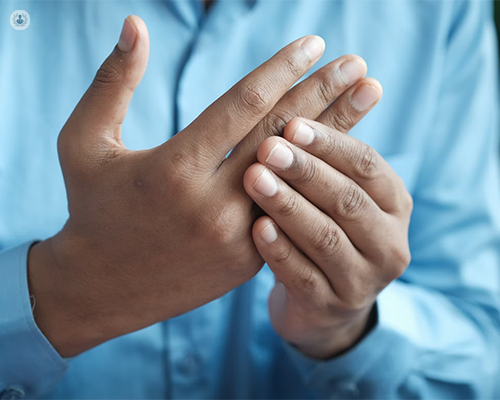What causes carpal tunnel syndrome?
Escrito por:Carpal tunnel syndrome (CTS) is a common condition that affects the hand and arm, causing pain, numbness, and tingling. It occurs when the median nerve, which runs from the forearm into the palm of the hand, becomes compressed at the wrist. The median nerve controls sensations to the palm side of the thumb and fingers (excluding the little finger) as well as impulses to some small muscles in the hand that allow the fingers and thumb to move.
On hand to provide more expert detail regarding the condition is Miss Kerstin Oestreich, a leading plastic, cosmetic, and hand surgeon.

What causes carpal tunnel syndrome?
Carpal tunnel syndrome is often caused by a combination of factors that increase pressure on the median nerve and tendons in the carpal tunnel. These factors may include congenital predispositions (the carpal tunnel is smaller in some people), repetitive hand movements, wrist anatomy, pregnancy, and conditions such as diabetes, thyroid dysfunction, and rheumatoid arthritis. Repetitive activities, particularly those involving the use of vibrating tools, prolonged use of a computer keyboard, or other repetitive hand movements, can contribute significantly to CTS.
What are the symptoms of carpal tunnel syndrome?
Symptoms typically start gradually with frequent burning, tingling, or itching numbness in the palm of the hand and fingers, especially the thumb and the index and middle fingers. Some people experience their fingers feeling useless and swollen even when no swelling is evident.
Symptoms of carpal tunnel syndrome often first appear in one or both hands during the night, as many people sleep with flexed wrists. A person with CTS may wake up feeling the need to "shake out" the hand or wrist. As symptoms worsen, they may feel tingling during the day, decreased grip strength, and difficulty performing tasks like buttoning clothes.
How is carpal tunnel syndrome treated?
Early diagnosis and treatment are crucial to prevent permanent damage to the median nerve. Initial treatments typically involve resting the affected hand and wrist, avoiding activities that may worsen symptoms, and immobilising the wrist in a splint to prevent further damage from twisting or bending. Nonsteroidal anti-inflammatory drugs (NSAIDs) can help relieve pain and inflammation.
In more severe cases, corticosteroid injections or surgery might be required. Surgery involves cutting the ligament that is pressing on the median nerve, which can relieve the pressure and alleviate symptoms.
Preventive measures include taking frequent breaks from repetitive tasks, stretching exercises, and ensuring proper ergonomic setups at workstations. Understanding and mitigating the risk factors for CTS can significantly improve one's quality of life and prevent the progression of the syndrome.


